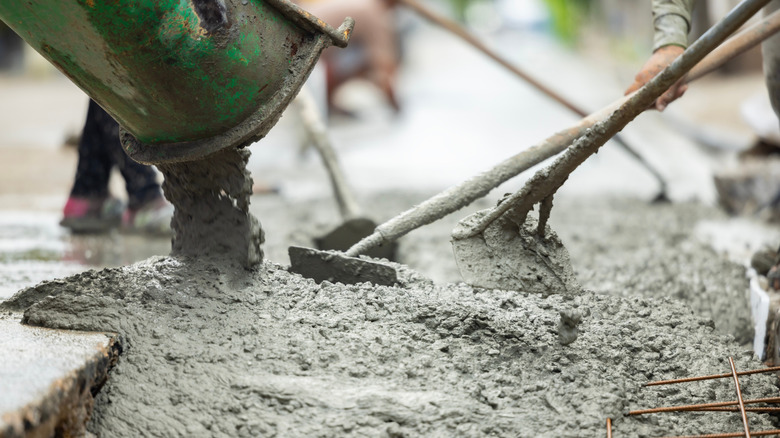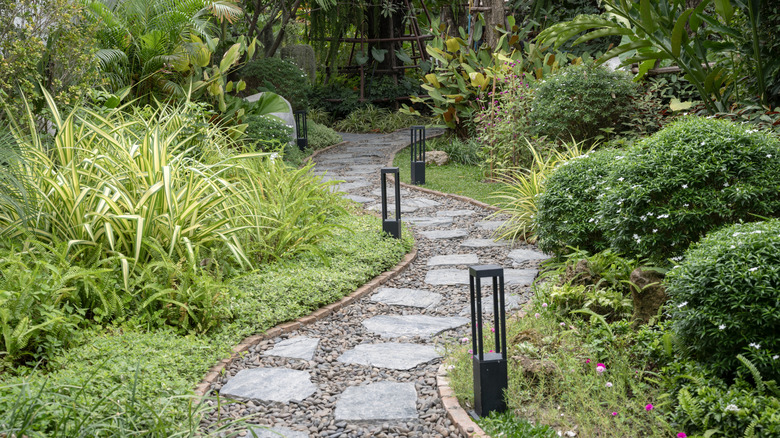The Budget-Friendly DIY That Turns Plain Concrete Into A Stunning Cobblestone Path
Concrete is an innovation that has been pivotal to human society since the days of the Roman Empire. It's a blend of several different materials, including limestone-based cement, sand, and a crushed stone aggregate that solidifies as ultra-solid calcium silica hydrates when mixed with water. Second century B.C.E. Romans used volcanic ash to mix concrete, which formed the basis of much of the empire's still-standing infrastructure. Today, it's the world's most-consumed construction material — made especially strong with reinforced steel rebar. However, concrete is not just the legendary stuff of both old empires and massive construction firms, you can buy your own concrete for personal projects, such as a DIY cobblestone path.
One of the main reasons concrete is so popular is due to the fact that it starts off as more of a liquid when first mixed with water, meaning it can be poured into almost any mold or shape before solidifying (over about 72 hours or so). This is why it's a popular choice for customized DIY projects like how to DIY your own concrete countertops. TikTok user Lisa Kamtansky (@lisakamtansky) even suggests that concrete doesn't need a solid mold to be useful. Instead, you can pour concrete into malleable plastic wrappings and let them set into natural stone shapes that fit together on your pathway. Given that you can buy bags of concrete mix for as little as $5 from retailers like Home Depot or Lowes, this can be a cheaper DIY than you might expect.
How to properly prepare concrete for cobblestone pathing
Mixing your concrete is going to be easiest with a paddle mixer, but with a pre-bagged mix you'll only have to worry about adding the water. You'll need to use a precise amount of water, as specified by your mix, and can add about two-thirds of that water requirement into your mixing bucket before adding the concrete materials. The rest of the water can then be poured in as you incorporate your mix, ending with a shiny top-layered blend that isn't too watery or crumbly. Once your concrete is ready to pour, Kamtansky recommends using cut squares of saran wrap as the container for your cobblestones, as you can lift it up by the corners and tie things off to keep the concrete together. To create bigger stones to visually break up your walkway, use trash bags instead.
One of the best things about this DIY project is that it won't require much in terms of planning the stone shapes. Because concrete is so malleable in its liquid form, putting multiple plastic-wrapped chunks together will let them naturally sag into place. If you want to go a step further, you can make your walkway look uniquely textured by mixing the concrete with rock salt. After the concrete is fully set, you can use a torch to burn the plastic away before grouting any joints between them.
A cobblestone path made with concrete is customizable
The way you decide to set your cobblestone path is ultimately up to your aesthetic interpretation. For example, you can really make your outdoor setting shine by mixing cobblestone and gravel, filling the spaces between main footholds with a looser material that looks more natural — and should make it easier to replace should problems arise. Glass landscaping can achieve the same effect, but with tiny crystals in a variety of colors for more visual interest. If you want more solid places to walk, you can skip the saran wrap in this DIY and use larger trash bags to create a walkway out of wider, flatter flagstones.
Concrete has formed the literal foundation for much of modern-day society, and it's also a material that has been used to foster creativity and art. While there are broader questions about the use of cement at an industrial scale given the high carbon dioxide emissions required to make it, there's no doubt that concrete will continue to play a huge role in our everyday life. Creating your own DIY cobblestone path is just one way you can carry that tradition forward in your own home.

